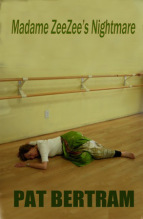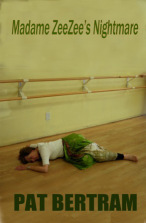Pat Bertram's Blog, page 151
October 21, 2016
Trying to Fill the Hole in My Book
When my life mate/soul mate died, I went into a tailspin of grief that lasted years. It came as a shock to me because I thought I was stoic and had my feet so solidly on the ground that I would be sad and lonely and then get on with the business of grief. The sort of grief I felt, I had never heard of before. I’d seen a few characters in movies shrie k in agony at their husbands’ funerals , but these theatrics always seemed more for effect than as a sign that half their soul had been ripped away.
k in agony at their husbands’ funerals , but these theatrics always seemed more for effect than as a sign that half their soul had been ripped away.
The few mentions of grief in novels were pretty lame. One book said, “She went through the five stages of grief.” That was the only mention of how the woman felt after the death of her husband, and it especially seemed phony because there are not five stages of grief or seven. There are an infinite permutation of emotions that come again and again in ever widening spiral until finally the spiral is wide enough you don’t feel the loss every moment of every day.
A character in another book cried one night, then woke up the next morning, with a determination to be done with tears, and she was. Again, this was a phony reaction. Sure, we can be determined to be done with tears, but grief has physical life of its own, throwing hormones out of whack and interfering with brain chemistry. Those physical effects cannot be ignored. They are there whether you want them or not. It’s not just that we go through grief, but grief also goes through us.
So, being both a writer and a woman who experienced grief, I decided I needed to write a novel about a woman going through grief. I wrote much of it during National Novel Writing Month the November after his death so I could show the emotions while they were fresh. To do the daily word counts required to “win” the challenge, I wrote whatever chapter came to mind.
Now, all these years later, I’m trying to put those scattered chapters into a reasonable facsimile of a novel. I’ve had to get rid of thousands of redundant words, had to winnow out many of the paragraphs that talked about her pain rather than showing her going through grief, and I have to struggle to make her likable even though she doesn’t much like herself. (Many of us don’t like ourselves when we are grief-stricken.) We are so bludgeoned into believing that we must be upbeat at all costs, that crying is for sissies, that emotions are to be controlled, that a character going through grief sounds like a whiner or a loser or a weakling.
I had envisioned the ending of the book as her driving off alone, probably because since I am alone, I can’t envision a different life. And anyway, it’s too soon for her to hook up. If I keep that same ending, I have a huge hole in the book, not just a lack of about 25,000 words, but a lack of character growth. You can’t have a woman whining and crying and screaming for most of a book, and then suddenly, it’s over with. What a cheat for the reader! If you suffer through all that sorrow, you need a bigger payoff. (Of course, in life there generally is no payoff, but in a story, there needs to be.)
So, this is what I’ve been doing the past couple of weeks when I haven’t been blogging — trying to figure out how to dig myself out of the hole. No success yet. Although I wanted to finish this book, I might have to set it aside when I get all those original chapters typed up and inserted into the proper place in the story. You can’t survive with a hole in your heart where love once lived, and a book can’t survive with a hole in its heart, either. I do have a cyber romance for her. I suppose I could fill that out a bit. I also have a a mystery about why her husband has a gun — I suppose I could fill that out too.
But still, the hole is there.
Could it be because I still have a hole inside me? If so, there’s not much I can do about it. Apparently, that hole is here for good.
***
Pat Bertram is the author of the suspense novels Light Bringer, More Deaths Than One, A Spark of Heavenly Fire, andDaughter Am I. Bertram is also the author of Grief: The Great Yearning, “an exquisite book, wrenching to read, and at the same time full of profound truths.” Connect with Pat on Google+. Like Pat on Facebook.
Tagged: am writing, filling the hole in my book, grief in fiction, work in progress, writing about grief


October 8, 2016
Out With the Old, In With the Older
Two-and-a-half years ago, when one of the women in my dance class found out I am an author, she suggested that I write a book about our class, and even volunteered to be the victim. I thought about it for more than a year, planning the story and trying to figure out a way around the many problems I could see, such as the women hating what I’d written about them. During a pleasant interlude, a little over a year ago, while staying with a friend, I started writing the book. And there it sat, all this time. Seven weeks ago, after making a commitment to write 250 words a day, I dug out the book and worked on it.
And now it is finished! I will let it sit for a while until I can read it with a fresh mind, then go over it one more time. And then — who knows. My publisher and I are at a standstill. He thinks he should have final say about such matters as typos and formatting because he is funding the project, and I think I should. I would rather not have the book published than give up even those simple rights, so who knows what will happen. Either way, it wouldn’t be published until late next year. Meantime, I am offering to send the manuscript to folks who want to read it in exchange for noting any typos they find. Let me know if you want to be one of these first readers.
next year. Meantime, I am offering to send the manuscript to folks who want to read it in exchange for noting any typos they find. Let me know if you want to be one of these first readers.
Today, I dug out another unfinished manuscript. This one is much more complicated. I started writing it in November of 2010, a few months after Jeff died. I wanted to try NaNoWriMo — National Novel Writing Month — where writers are challenged to write 50,000 words in the thirty days of November. The only way I could manage the word count was to write chapters as I thought of them. So now I am faced with a stack of unrelated chapters with a lot of repetion and no idea how to string them together. Even worse, they are all hand written, so I also have to type them. Worst of all, scenes I thought I’d written, I hadn’t, and now I don’t remember what needed to go into those crucial scenes to make the story work. Eek.
I do have the first fourth of the book typed and in chronological order, but it shows a woman in the first throes of grief, and I worry that her many tears and screams would be off-putting. Still, that is a job for the editing process, when I’ve gotten the story into a first draft. But, mingled with the tears are hints of a deeper story. A gun hidden in a closet. A suicide note. A box with gun oil and stained rags. A file that was password protected. Oh, and a cyber affair.
The woman was married to a preacher and will be evicted from the manse, which adds even more pathos to the story, but I can’t find the eviction scene. Maybe I decided they had bought a house, and she turned it over to her daughter? I guess I’ll find out in the writing! I do like the idea of one trauma piled on another, though. The woman seems a bit weak, all those tears and whines about not knowing who she is if she doesn’t know who her husband was, and putting her through more stress than a person can handle would be a good way of seeing what she’s made of.
I’d actually planned to finish another book first, one I started the year before Jeff died. It will actually be easier from a writer’s point of view because the book is three-fourths finished, and I know what the story is, but it’s harder from an emotional point of view. The idea came from him, and it hurts that he won’t be in at the finish.
Still, it’s best to do the emotional books first, get them out of my head.
Since, apparently, I am working backward, the final book will be the complete revision of my first book. The idea still intrigues, but I started it long before I learned how to write, maybe seventeen years ago, so I will probably have to start from scratch. There is a sex scene in the book, though, and I hope that is salvageable since each book I write seems to become more chaste than the last.
Meantime, I am dealing with this mess, trying to wrangle it into a cohesive story.
Ah, the fun that awaits me!
Tagged: 250 words a day, a book worth finishing, dance class book, finishing a book, starting a new book


September 30, 2016
Fun with Fiction
 Yesterday and the day before, I did errands and chores so that I would have three danceless and carefree days for a writer’s retreat.
Yesterday and the day before, I did errands and chores so that I would have three danceless and carefree days for a writer’s retreat.
It’s been a long time since I’ve had the mental discipline to work so continuously on a novel. Now that I’m in the swing of things, I make sure I write every day to keep up the discipline.
It’s also been a long time since I’ve had so much fun with fiction, but perhaps that’s because I am integrating my blogging style into my current novel, a story that takes place in the dance studio where I have classes. There are plenty of hard-boiled mysteries out there for lovers of sordid urban backgrounds and those who prefer graphic sex or violence or both, so I feel no need to indulge those tastes. Instead, my poor detective — based on me — is more of a thinker. Let’s hope she finds the truth in the end.
Excerpt from Madame ZeeZee’s Nightmare:
I lay back on the pillow, arms behind my head, and thought about Margot and me and how, through a convoluted series of events, we ended up in the same place.
Because every action impinges on every other action, even down to the most minute particle or wave, the confluence of our lives would have had to begin billions of years ago, when the universe burst into being. Through untold eons the Everything developed increasingly complex life forms, and finally, it created a semblance of a human being. A million years later, our present species sprang forth, and many thousands of years after that, I was born in the United States of America. I — a bookish child with no talent or energy for physical activities — grew up, loved deeply, got married, became widowed, and traveled a thousand miles to Peach Valley to care for a dying old man.
One day, while waiting to meet a woman from my grief group for lunch, I noticed Madame ZeeZee’s studio, took a chance, and went inside. I never had a list of things I wanted to do before I die (does anyone have a list of things they want to do after they die?) because I want the miraculous: a love I never knew. And that’s what happened with dance.
Margot’s individual journey started nine years after mine when she was born in Lithuania with a love of dance. Her life of physical and mental discipline ended in murder and a six thousand mile trip into the unknown. And somehow, those two cosmic journeys—that of the bookish child and the ballerina—bisected at Madame ZeeZee’s studio.
Not a nightmare, but a marvel.
***
Pat Bertram is the author of the suspense novels Light Bringer, More Deaths Than One, A Spark of Heavenly Fire, andDaughter Am I. Bertram is also the author of Grief: The Great Yearning, “an exquisite book, wrenching to read, and at the same time full of profound truths.” Connect with Pat on Google+. Like Pat on Facebook.
Tagged: bookish child, discipline of writing, Lithuanian ballerina, Madame ZeeZee's Nightmare, thinking detective, work in progress, writer's retreat


September 24, 2016
Happy Ninth Bloggiversary To Me!
I created this blog exactly nine years ago today, back when I hadn’t yet become a published author, back when I didn’t even know what a blog was. I’d read how important blogging was for authors, both as a way of getting known and as a way of connecting with readers, so I decided to “act as if” I were going to be published in the hopes of making it happen. I had nothing to say, no one to say it to, no reason to say anything, but I didn’t let that stop me. I started blogging on September 24, 2007, and haven’t stopped since, though admittedly, I don’t post as much as I once did.
Did acting as if I were goin g to get published work? Perhaps, though there is no direct connection that I know of. Still, one and a half years after starting this blog, my first two books were published, I now have five books published by Indigo Sea Press — four suspense novels and one non-fiction book about grief. More importantly — at least blog-wise — I am still blogging, still making connections, still making friends. Still having fun.
g to get published work? Perhaps, though there is no direct connection that I know of. Still, one and a half years after starting this blog, my first two books were published, I now have five books published by Indigo Sea Press — four suspense novels and one non-fiction book about grief. More importantly — at least blog-wise — I am still blogging, still making connections, still making friends. Still having fun.
One thing I never expected when I set up Bertram’s Blog, is how much I would like writing and publishing my articles. I feel safe here, away from the constant promos, ideological ravings, and mindless ratings on other sites, and it gives me the freedom to say what I want, no matter how personal. Six and a half years ago, my life mate/soul mate died, and his death catapulted me into such a world of such pain that it bled over into my posts. This blog became a place where I could try to make sense of what I was going through, to offer comfort and be comforted, to find my way to renewed life. This blog sustained me during the years I cared for my father, and it gave me a place to rest after my father died, when I was thrown out into the world, alone and orphaned. And this blog offered me a place to call home when I set out alone on a five-month, 12,000 mile cross-country road trip, gave me a place where I could talk about all the wonders I was seeing. Often on that trip, when I was between visits with online friends, I thought of William Cowper’s words: How sweet, how passing sweet, is solitude! But grant me still a friend in my retreat, whom I may whisper, solitude is sweet. And this blog became a place where I could whisper, “Solitude is sweet.”
It’s nice to know that whatever life throws at me, whatever problems I encounter, whatever challenges and adventures come my way, this blog will be here for me.
Although I’d planned to post every day when I started blogging, during the first four years I only managed to blog three or four times a week, but exactly five years ago today, I made a 100-day commitment to post a daily blog, and once that initial commitment was fulfilled, I continued to post every day for four and a half years. I probably would still be blogging every day except I got out of the habit of daily posts while on my great adventure because so often on the road, I had no internet connection, not even with my phone. And now that I have the internet again, I have few internal (or external) conflicts to give me blog topics.
But still, the blog is here, always welcoming me when I do find something to say, generally once or twice a week. (I am still writing every day, of course, but now I am working on another novel.)
During the past nine years, I have written 2,163 blogs, received 14,835 comments, and garnered 528,360 views. It amazes me that anyone wants to read anything that I write here. This is so much a place for just letting my thoughts roam, for thinking through problems, and (I admit it) for pontificating a bit. It’s been a kick, writing this blog, and I want to thank all of you for indulging my whims and whimsys.
Thank you for reading. Thank you all for your comments, your likes, your support. They have meant more to me (especially this past six and a half years) than you can ever imagine.
***
Pat Bertram is the author of the suspense novels Light Bringer, More Deaths Than One, A Spark of Heavenly Fire, and Daughter Am I. Bertram is also the author of Grief: The Great Yearning, “an exquisite book, wrenching to read, and at the same time full of profound truths.” Connect with Pat on Google+. Like Pat on Facebook.
Tagged: acting as if, being me, blogging, bloggiversary, daily blogging, grief and blogging, Indigo Sea Press


September 17, 2016
On Writing: Dredging Up Emotion
When I started writing novels, I wrote longhand because I didn’t have a typewriter or a computer. After I got a computer, I continued writing longhand. I believed that I had a better finger/mind connection writing by hand than I did typing and, in fact, many researchers have discovered the truth of that connection.
After a few months of being on the internet and having a computer, I became comfortable writing my blogs on the computer. It was easier not to have to retype my words, and luckily, I didn’t have any problem figuring out what to say or how to say it.
I have recently resumed writing novels, and I have no inclination to go back to longhand. For one thing, I now have a hard time holding a pen for any length of time without my fingers cramping, and for another, I can’t read my handwriting and type at the same time. If I can see the written page, I can’t see the words on the computer screen. If I can see the words on the computer screen, I can’t see the written page. Just one of the many ironies of dealing with a body that is slowly aging. (I’m grateful it’s aging slowly and that I haven’t yet reached the falling elevator stage of getting old.)
 I have discovered a couple of interesting points about writing a book on a computer. It goes so much faster. I can type almost as fast as I can think of things to say, which sometimes is a glacial pace and other times like a running faucet. And I feel the emotions of my character. Perhaps I feel the emotions because they are mine. The main character is a writer named Pat. Coincidence? Maybe. Even I no longer know for sure. (I am getting confused which dance class is real — the one on my computer screen or the one in the studio. The other day in the studio, I talked about a classmate “Jackie” and everyone looked at me as if I were nuts. I could be. Jackie was the alias I gave to one of our classmates for the book.)
I have discovered a couple of interesting points about writing a book on a computer. It goes so much faster. I can type almost as fast as I can think of things to say, which sometimes is a glacial pace and other times like a running faucet. And I feel the emotions of my character. Perhaps I feel the emotions because they are mine. The main character is a writer named Pat. Coincidence? Maybe. Even I no longer know for sure. (I am getting confused which dance class is real — the one on my computer screen or the one in the studio. The other day in the studio, I talked about a classmate “Jackie” and everyone looked at me as if I were nuts. I could be. Jackie was the alias I gave to one of our classmates for the book.)
I still feel that there is a better connection with my mind when I write by hand, but I think it’s a mind connection rather than an emotional one, and it took me too deep. Typing on the computer may not deliver ponderous thoughts to the page, but it does help me dredge up emotions, which aren’t quite as deeply buried.
For example, as I wrote the following paragraphs, I could feel the anger building, and the anger stayed with me even after I closed my computer. I don’t know if that’s good for my peace of mind, but if the anger comes through to the reader, that’s great.
Excerpt:
I froze. I didn’t just go rigid, I also got chilled, as if my internal temperature had dropped about twenty degrees.
As one, Rose, Kim, Buffy, Rhett, Lena, and Allie turned to stare at me. If Madame ZeeZee noticed, she would have been pleased to see their acting as a single entity. Margot and Jackie followed the other women’s example and glanced my way, but the two ballerinas didn’t seem to know what was going on. And maybe they didn’t know. They hadn’t been at the lunch where we’d discussed ways of killing Grace.
Deep inside my arctic body, I found my voice. “Why are you looking at me? I’m not the one who came up with the insulin scenario.”
“But you’re the one killing us,” Rhett said.
I went from ice to fire in an instant. “What the hell is wrong with you people? Do you really think I’m so powerful that my thinking of writing a story about murder will kill you? If so, you’d better be damn good to me, or I’ll write you off next.”
Jackie laughed. “You tell them, Pat.”
“Grace’s death was your fault,” Lena said.
I whipped off the belly dance skirt I’d donned a few minutes before. “I can’t do this. I’m sorry Grace is gone, but I’m not the one who initiated some insane pissing contest that got her killed.” I grabbed my street shoes, and opened the door. “I’m going home to put all of you in my book. Goodbye.”
The door closed slowly, as if their silence were a physical presence so great it couldn’t be contained. Right before the door completely shut, Rose’s words drifted out. “Did ya’ll hear that? Did she really say ‘pissing contest’?”
Ah, so much fun!
***
(Pat Bertram is the author of the suspense novels Light Bringer, More Deaths Than One, A Spark of Heavenly Fire, and Daughter Am I. Bertram is also the author of Grief: The Great Yearning, “an exquisite book, wrenching to read, and at the same time full of profound truths.”)
Tagged: dance murder excerpt, mind-hand connection, putting yourself in a novel, writing a book on the computer, writing longhand, writing on the computer


September 15, 2016
Positivity is the world’s saving grace
“I’d like to invite you to join me for two days of pure positivity. Forty-eight little hours of looking for and at only the good stuff. Of ignoring what isn’t beautiful. I’m not asking you to give up misery forever. Forty-eight hours and one minute from now, you are welcome to seek out all the stuff that makes you angry, sad, frustrated, and worried, but for two days, let’s sweep all that under the rug and then dance atop it. What do you say, are you in?” – Beth Grace in Your Voice Within
Focusing on the good stuff ain’t easy.
 Seems like the world throws a lot of curve balls at us and our friends–and at other good people as well. Getting depressed or angry is probably a very human response.
Seems like the world throws a lot of curve balls at us and our friends–and at other good people as well. Getting depressed or angry is probably a very human response.
Plus, many of us have “hot buttons,” issues that almost automatically bring fire-breathing anger and personal issues that…
View original post 776 more words


September 11, 2016
Joys of the Writing Life
I am still writing!!! I have always been a slow writer, but my current work is just flying along. It helps that I know the characters. The main character is me so there is no reason to create artificial conflicts, weakness, or strengths. They are all there is living color. (To be exact, they are there in black and white since the page is white and the words are black.) I would have thought using a real person as a character would make the writing harder because I can’t create the character to fit the plot. In many ways, the character herself is creating the plot — what she thinks, what she does, what she fears, what she grieves.
The other characters, at least some of them, are based on the women in my dance class, which makes things easy. If I need to describe something or someone, I can describe what I know. Unfortunately, I am having a hard time making them come alive. I am hesitant to attribute bad qualities to them, real or imagined, and I don’t want to create havoc in their lives by giving them secrets, such as a secret lover. Can’t you just hear it?
Husband: Character B is you, right?
Character B: Yes. Isn’t this great?
Husband: And it’s based on your life.
Character B: Yes, but it’s fictionalized
Husband: So who is this guy you’re having an affair wth?
Character B: I’m not having an affair.
Husband: You said Character B is you.
Character B: A fictionalized me.
Husband: And Character B is having an affair.
Character B: Yes, in the book I am having an affair.
Husband: So who is he? Do you want a divorce? Is that what you’re saying?
Character B: No. I’m saying I’m character B.
Husband: Do you want to leave or do you want me to leave?
It’s a big enough responsibility shaping one’s character’s lives, to have the real person influence the character. Having the character influence the real person is more responsibility — and guilt — than I can handle.
So, these characters so far are just walla-wallas. (In old time court room dramas, when the trial watchers were supposed to murmur to show excitement at a revelation or verdict, they said, “Walla, walla. Walla walla.”)
To help the story along, I combined several women into a few fictional ones, which gives me the benefit of being able to have them do what I want without worrying about ruining their lives. And I can go back and change these characters as necessary to fit the story.
Other things that are making this story run smooth: 1) It’s rather stream-of-consciousness — not too much, I hope — and stream of consciousness is easy for me. Just tell what I know and show what I feel. 2) I’ve been mulling over this idea for two years, so much of the story is already in my head. 3) Since this is a mystery that takes place at a dance studio, and since I am taking lessons, every day offers inspiration. 4) I am typing the story instead of writing longhand. I wrote my other books longhand because I feel it gives me a better finger/mind connection — and I didn’t have a typewriter or computer — but I can’t hold a pen for long periods of time anymore, and I can’t read my writing afterward. 5) Mostly, I’m putting myself in a position to write. I joined a 250-word-a-day club, and when I am too tired to think, I tell myself “just do your 250 words and then you can stop”. But by then, I’m into the story, and I need to finish the current scene before I forget it.
It’s not much of an exciting life. Nothing to discuss, no adventures to talk about, no conflicts or great emotions to try to work out. Just me in my fake/real world. One thing that is notable: I forget sometimes and call the real people by their fake names. And sometimes I refer to an episode in the book as having really happened. Ah, the joys of a writing life!
***
(Pat Bertram is the author of the suspense novels Light Bringer, More Deaths Than One, A Spark of Heavenly Fire, and Daughter Am I. Bertram is also the author of Grief: The Great Yearning, “an exquisite book, wrenching to read, and at the same time full of profound truths.”)
Tagged: great emotions, no conflicts in life, stream of consciousness writing, the writing life, using real people as characters, walla-walla, what people murmur in courtroom dramas


September 4, 2016
The Beauty and Amusement of Writing
 I have been enjoying being a character in my book, enjoying even more finding inspiration in the small matters of my life. For example, yesterday I wrote in a blog post:
I have been enjoying being a character in my book, enjoying even more finding inspiration in the small matters of my life. For example, yesterday I wrote in a blog post:
I tend to believe my memory. Whenever I have gotten into a he said/she said or she said/she said argument, I can often find some sort of corroboration for my side, such as in a text or an email, which adds credence to my belief. Also, in dance class, I often remember steps when others don’t.However, there are a few steps from a dance we performed eighteen months ago that are completely gone from memory. Erased. I watched a video of that performance to see what the steps in question were, and even though I could see myself doing the steps, I have no memory of them.
It seemed such an interesting lapse, that I used the episode, which for some reason I found amusing, as a jumping off place for this rather chilling scene in the book:
I prided myself on having a good memory, and I believed everything it fed me. Whenever I’ve become party to a he said/she said or she said/she said argument about something that had happened, I could often find some sort of corroboration for my side, such as in a text or an email, which added credence to my belief. Also, in dance class, I often remember steps when others don’t.
Madame ZeeZee watched us practice a dance we should have known well because we had performed it a year previously in a concert at the local college.
We’d been working on new dances recently and hadn’t practiced that particular dance in several months, but we did okay without either Grace or Madame ZeeZee dancing in front of us. Until the final verse. In Hawaiian, each verse is repeated twice in exactly the same way, but in this particular dance—“Green Rose”—when the last verse repeated, we did different steps than we had the first time the verse played. Deb did something I knew was wrong for that last verse and the rest of us foundered. I stood there while the music died out, trying to recall the right steps, but I had absolutely no memory of that final sequence.
We danced “Green Rose” a second time, with Madame ZeeZee leading us. I did the dance perfectly, but only because I watched her. I didn’t remember ever having done those final steps before. It was as if the memory had been completely erased.
Walking home after class, I pondered the mystery of my missing memory. Could this be the beginning of Alzheimer’s? Or could I always have had blank spots in my memory? If so, how would I know? I only knew what I remembered.
I did remember telling Jackie once that I was an unreliable narrator, but I’d been talking about my lack of attention to details, not my memory. But now I wondered about Grace’s death.
Could I have done something besides play her mystery game that got her killed? Did Deb know what I had done, and that’s why she claimed the death was all my fault? I refused to believe the ghastly thought. Erasing a few steps of a dance was one thing, but losing the memory of a murder was something completely different.
Still, I hardly slept at all that night, and when I did, I dreamed of shadowy beings I should have remembered, but didn’t.
Ah, the beauty and amusement of writing!
***
(Pat Bertram is the author of the suspense novels Light Bringer, More Deaths Than One, A Spark of Heavenly Fire, and Daughter Am I. Bertram is also the author of Grief: The Great Yearning, “an exquisite book, wrenching to read, and at the same time full of profound truths.”)
Tagged: having fun writing, Hawaiian dancing, he said - she said, inspiration from life, lapse of memory


September 3, 2016
Flawless Characters
Everyone who knows anything about writing or reading novels knows that you have to start with a flawed character. Well, everyone but me. I don’t believe in flawed characters, just characters that come alive.
Tell me honestly, except for a few physical attributes that you might not like about yourself, do you think you have flaws? No, of course you don’t. You think you have problems. You laugh about your quirks. You are beset with internal conflicts. You might even have a list of traits that you try to work on, such as trying to be kinder or more disciplined, but you don’t have flaws. You are who you are. All the parts, good and bad (and who is to say which is which) make up your character.
To me, the character flaw is like the Persian Flaw. The Persian rug makers purposely put a flaw into each of their rugs supposedly because of their belief that only God can make something perfect. That speaks to me of arrogance, to believe you are so absolutely perfect you have to create a flaw to make yourself less than perfect. It’s the same with the character flaw in writing. If you create a realistic character, there is no flaw, just a character w ith a mixture of admirable and not so admirable points. To add a flaw on purpose takes away from the realism of the character. At least to my way of thinking, and now I have proof of sorts.
ith a mixture of admirable and not so admirable points. To add a flaw on purpose takes away from the realism of the character. At least to my way of thinking, and now I have proof of sorts.
I am writing a novel about a fictitious death in my dance class. I began using all my classmates as characters, but gradually I have been camouflaging them by changing names and creating omnibus characters — combining two or three classmates into a single character to avoid hurting anyone’s feelings. And I had to create a couple of wholly fictitious characters because a mystery is primarily about unraveling the back story to find out why the victim was killed and why the killer was so motivated. I didn’t want to create fictitious backgrounds for my classmates because when it comes to murder, there are no innocent folk, or at least not often. The victim — and the red herrings — usually has done something to set the whole thing in motion. And it’s those “something”s I worried about attributing to people I meet every day. Who needs that kind of pressure?
I started out with myself as the unreliable narrator, and when I blurred the edges of the others in my class, I kept the real me as a character. If I had known how easy this made writing a novel, I would have done it long ago! I don’t need to create a character. Don’t need to do psychological profiles. Don’t need character arcs or family trees. It’s all here, in my head. In me.
And especially, I don’t need to create flaws. I don’t particularly consider myself a flawed character, though I do have some character traits that are less than saintly. And I have a few other traits that come from lapses.
For example, I tend to believe my memory. Whenever I have gotten into a he said/she said or she said/she said argument, I can often find some sort of corroboration for my side, such as in a text or an email, which adds credence to my belief. Also, in dance class, I often remember steps when others don’t. However, there are a few steps from a dance we performed eighteen months ago that are completely gone from memory. Erased. I watched a video of that performance to see what the steps in question were, and even though I could see myself doing the steps, I have no memory of them. Is this memory lapse a flaw? Not particularly. It’s just a . . . lapse. Is the insistence on the accuracy of my memory a flaw? No. That’s also just a lapse.
The best part of using myself as a character is that I never have to worry about creating a conflicted character. Every page illuminates my internal conflicts about death, finding my place in the world, trying to do the right thing and failing, dancing to a different beat. (I think that’s why I like dancing so much — for once in my life, I get to do exactly what everyone else is doing without the conflict of having to choose between being out of step with the world or being out of step with myself.)
So there you have it — proof that you don’t need flaws to create a good character. You just need realistic traits.
Note: Please don’t leave comments telling me that there is no such thing as a perfect character, that they need flaws to be realistic. I’ve heard all the arguments. You believe what you want. I know the truth. Oops. Did I just show a character flaw?
***
(Pat Bertram is the author of the suspense novels Light Bringer, More Deaths Than One, A Spark of Heavenly Fire, and Daughter Am I. Bertram is also the author of Grief: The Great Yearning, “an exquisite book, wrenching to read, and at the same time full of profound truths.”)
Tagged: character flaw, character traits vs flaws, death in dance class, flawed characters, flawless characters, Persian flaw, unreliable narrator


September 2, 2016
Coming Home
I am creating another writer’s retreat for myself this weekend, but to tell the truth, right now my whole life feels like a writer’s retreat. I continue to feel conflict free, partly because I have put off worrying about the future and what is to become of me, and partly because I have temporarily found a safe place to land. (Hard to believe, but I’ve been here a whole month already!) So far, my roommates are working out, with only minor irritations that I choose to let go and not obsess over. Surprisingly often, I have the house to myself, and best of all, even though I still don’t have a remote garage door opener, I do have use of the garage, which pleases both me and my aged vehicle.
I am living day to day (to the extent that it’s possible), making a point of noticing my moments, and being grateful for the good things in my life. With the questions and worries that usually plague me on hiatus, my stream of consciousness has nothing to do but let my work in progress steep, so I don’t often find myself tongue-tied (finger-tied? word-tied?) when I open the computer to work on my book.
am living day to day (to the extent that it’s possible), making a point of noticing my moments, and being grateful for the good things in my life. With the questions and worries that usually plague me on hiatus, my stream of consciousness has nothing to do but let my work in progress steep, so I don’t often find myself tongue-tied (finger-tied? word-tied?) when I open the computer to work on my book.
I am going to dance classes four days a week and enjoying it as much as I did in the beginning, perhaps because when people irritate me, I can take them out of my head and put them in my story. Although I spend the remaining three days of the week working on my novel, I am sticking with the 250 words a day club, so I manage to write a bit every day. I am usually not one of those writers who live by word counts, but because of the club, I am keeping track of my words. I was thrilled when I realized that in the past two weeks, I have added 10,000 words to my novel. Wow! You might not be impressed, but I am.
I do continue to have a bit of a reality lapse when I go from my fictitious class to my real-life class, but trying to remain in the moment helps. And my teacher in life as well as in the book is always kind to me, which helps make for an even transition.
A real boon for my book has been my online life. For the most part, once I got online, I stopped writing fiction and went to blogging. I blogged everyday for about five years, but without conflict or adventure to fuel my posts, I don’t have much to say, so I have let fiction writing replace blogging. Now whenever I have a question, I Google it rather than spending months trying to find the information in the library, and if Google doesn’t have an answer for me, there is a whole slew of people all around the world to ask. Not only have I gotten medical information from a doctor friend, and help with the structure of a mystery story from a writer’s group, people have even offered me wonderful suggestions for motivation. (Not being a murderous type myself, ingenious motivations for committing such a crime are hard for me to come up with. I’d be more of a slam-bam-goodbye-ma’am sort of killer rather than a revenge-is-a-dish-best-served-cold murderer.)
The most wonderful thing about being back in writer’s mode is that I feel as if I’ve come home. So much of my internal conflict since Jeff died and more recently my dad, is that I have nowhere to call home. And now I do — inside my head, playing with words.
Not a bad place to be.
***
(Pat Bertram is the author of the suspense novels Light Bringer, More Deaths Than One, A Spark of Heavenly Fire, and Daughter Am I. Bertram is also the author of Grief: The Great Yearning, “an exquisite book, wrenching to read, and at the same time full of profound truths.”)
Tagged: 250 words a day, blogging vs fiction writing, feeling conflict free, internal conflicts, stream-of-consciousness, writer's retreat, writing online






